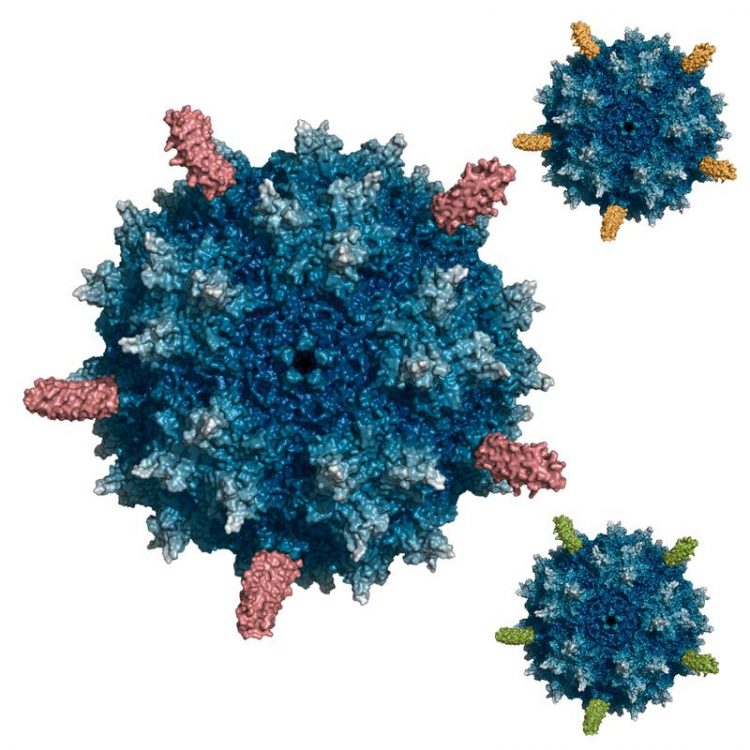Precise gene transfer into therapy relevant cells after vector injection into blood

Vectors derived from adeno-associated viruses (AAV) were used as vehicles for targeted gene transfer by the research group of Professor Christian J. Buchholz, Principal Investigator at the LOEWE Centre for Cell and Gene Therapy at Frankfurt am Main and head of the Section “Molecular Biotechnology and Gene Therapy ” of the President of the Paul-Ehrlich-Institut.
AAV is a non-pathogenic parvovirus. The only gene therapy medicinal product authorised in Europe so far, is also based on AAV gene vectors and intended for the treatment of a rare metabolic disorder.
The strategy for the generation of the new precision gene vectors was developed and implemented jointly with Dr Hildegard Büning, head of the AAV Vector Development Research Group at the ZMMK (Zentrum für Molekulare Medizin Köln, Center for Molecular Medicine Cologne) of the University of Cologne: Through exchange of two amino acids, AAV lost its ability to bind to its natural receptor and became thereby unable to penetrate its broad range of natural target cells.
Novel target structures (DARPins, designed ankyrin repeat proteins) were then attached to the surface of the modified vector particles. These structures were developed at Zurich University. The structures can be selected in such a way that they mediate a selective binding of the DARPin-containing AAV vector particles to the therapy relevant cell type only.
This is what enables the AAV vector to attach to and penetrate the desired target cell. The paper referenced here reports on the use of three different DARPins, which equipped AAV vectors either with a specificity for Her2/neu, a tumour marker in breast cancer, for EpCAM, an epithelial surface protein, or for a marker of particular blood cells (CD4 on the surface of lymphocytes with distinct immunological functions).
In the mouse model, the vector for Her2/neu targeted 80 percent of all metastatic sites after only a single injection. If the vector was armed with a cytotoxic gene, the survival rate of the mice was substantially prolonged compared to mice receiving an authorised anti-tumour product. Using the EpCAM-targeted vector, tumour cells could be detected with impressive sensitivity in human blood (few hundred tumour cells in several millilitres of blood).
The desired goal of a cell type specific in vivo gene transfer was also achieved with the blood cell targeted vector: AAV transferred the gene only into lymphocytes present in spleen carrying the CD4 protein target structure.
“The method developed by us jointly is a very promising tool both in fundamental research and for the targeted gene transfer in medicine“, explained Dr Buchholz with regard to the current research results.
Original Publication
Münch RC, Muth A, Muik A, Friedel T, Schmatz J, Dreier B, Trkola A, Plückthun A, Büning H, Buchholz CJ (2015): Off-target-free gene delivery by affinity-purified receptor-targeted viral vectors. Nat Commun Feb 10 [Epub ahead of print].
http://www.nature.com/ncomms/2015/150210/ncomms7246/full/ncomms7246.html
The Paul-Ehrlich-Institut, Federal Institute for Vaccines and Biomedicines in Langen near Frankfurt/Main, is a senior federal authority reporting to the Federal Ministry of Health (Bundesministerium für Gesundheit, BMG). It is responsible for the research, assessment, and marketing authorisation of biomedicines for human use and veterinary vaccines. Its remit also includes the authorisation of clinical trials and pharmacovigilance, i.e. recording and evaluation of potential adverse effects. Other duties of the institute include official batch control, scientific advice and inspections. In-house experimental research in the field of biomedicines and life science form an indispensable basis for the varied and many tasks performed at the institute. The PEI, with its roughly 800 staff, also has advisory functions at a national level (federal government, federal states (Länder)), and at an international level (World Health Organisation, European Medicines Agency, European Commission, Council of Europe etc.).
Media Contact
All latest news from the category: Life Sciences and Chemistry
Articles and reports from the Life Sciences and chemistry area deal with applied and basic research into modern biology, chemistry and human medicine.
Valuable information can be found on a range of life sciences fields including bacteriology, biochemistry, bionics, bioinformatics, biophysics, biotechnology, genetics, geobotany, human biology, marine biology, microbiology, molecular biology, cellular biology, zoology, bioinorganic chemistry, microchemistry and environmental chemistry.
Newest articles

NASA: Mystery of life’s handedness deepens
The mystery of why life uses molecules with specific orientations has deepened with a NASA-funded discovery that RNA — a key molecule thought to have potentially held the instructions for…

What are the effects of historic lithium mining on water quality?
Study reveals low levels of common contaminants but high levels of other elements in waters associated with an abandoned lithium mine. Lithium ore and mining waste from a historic lithium…

Quantum-inspired design boosts efficiency of heat-to-electricity conversion
Rice engineers take unconventional route to improving thermophotovoltaic systems. Researchers at Rice University have found a new way to improve a key element of thermophotovoltaic (TPV) systems, which convert heat…



